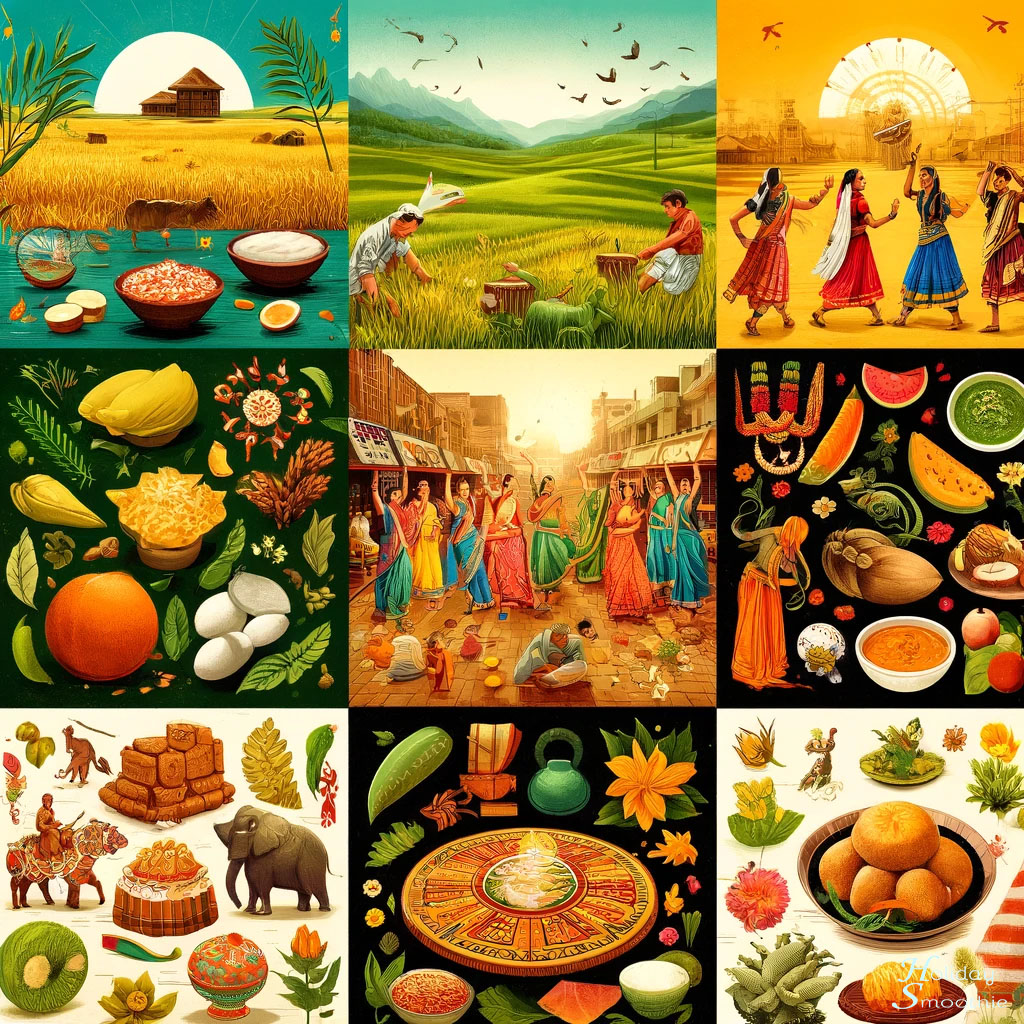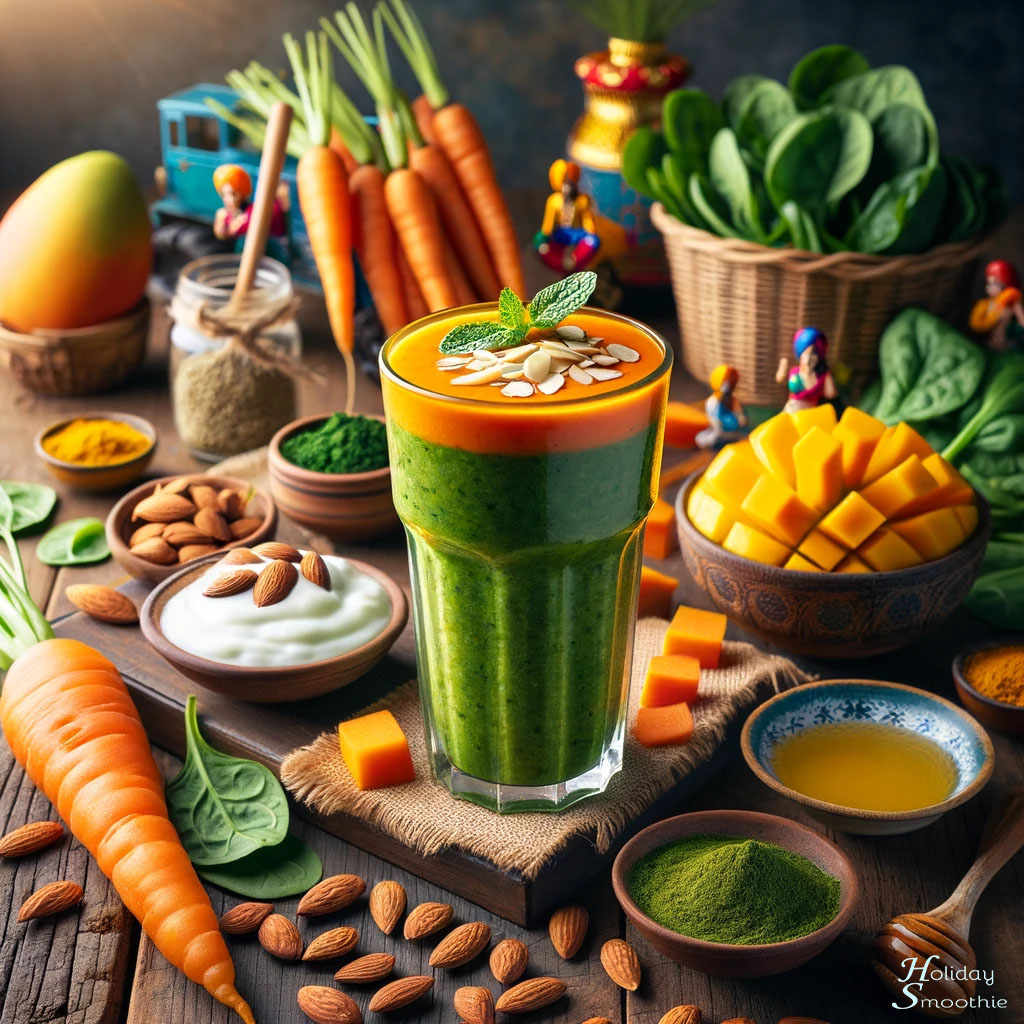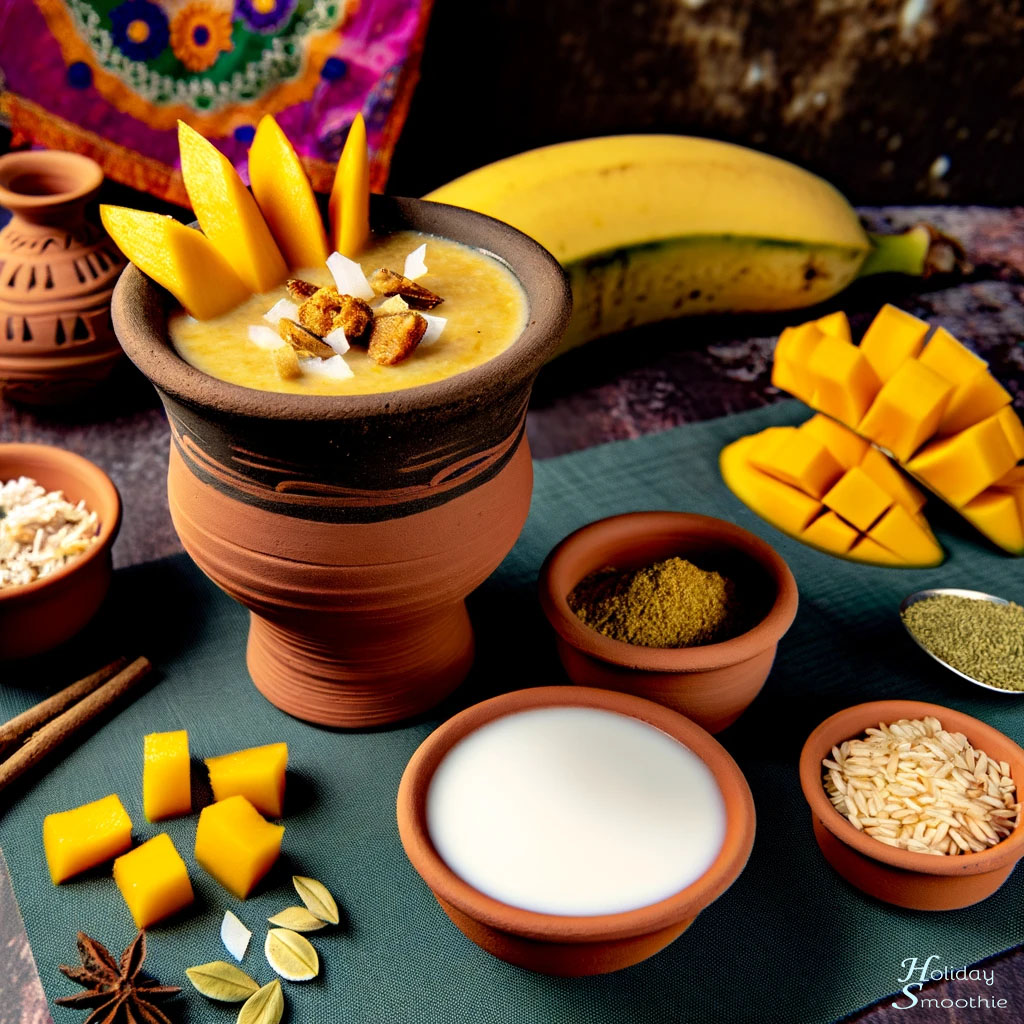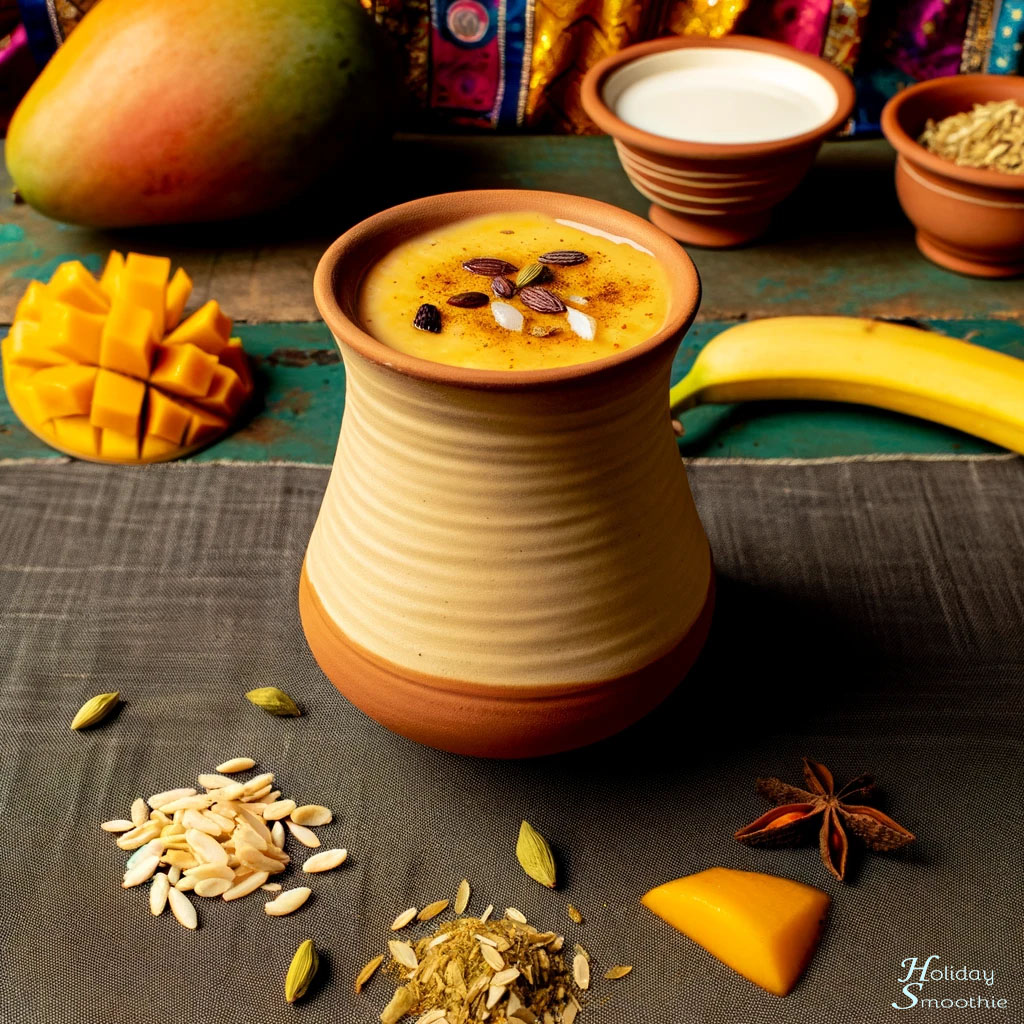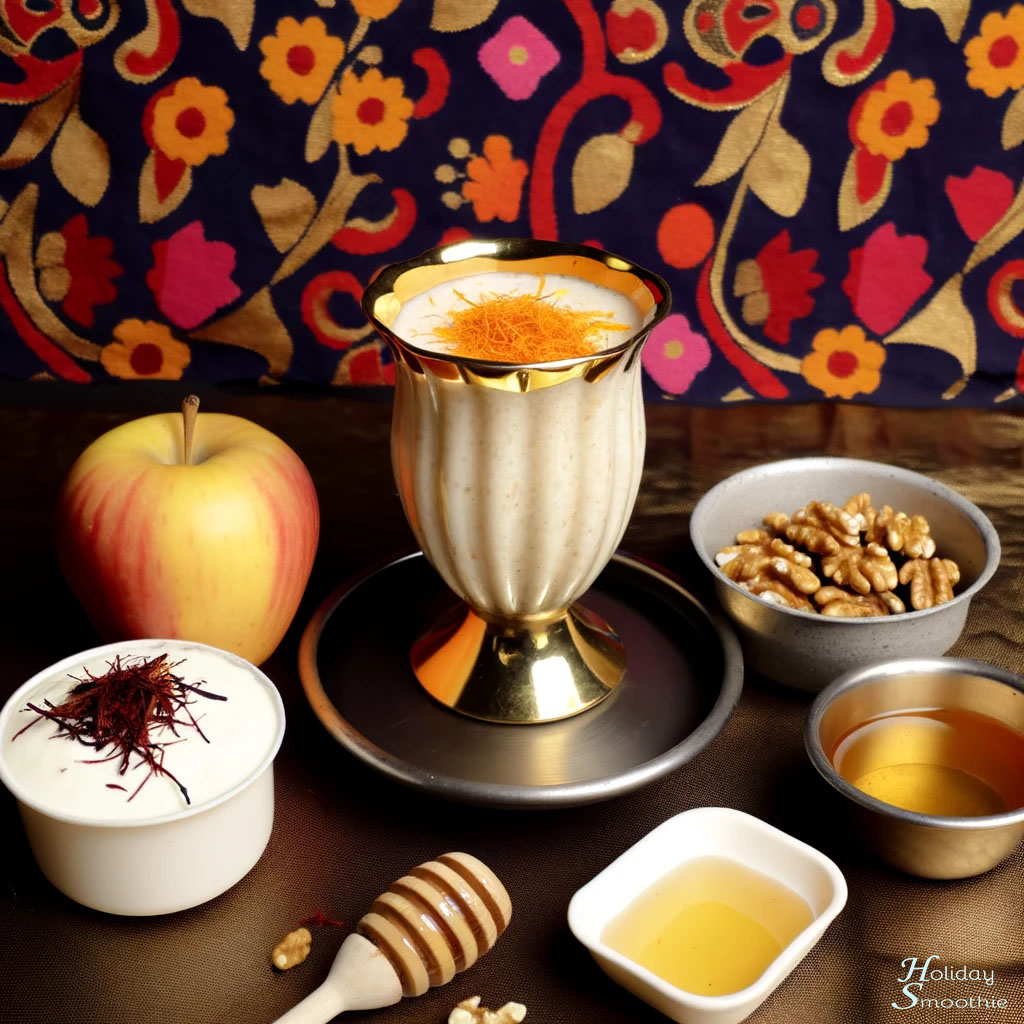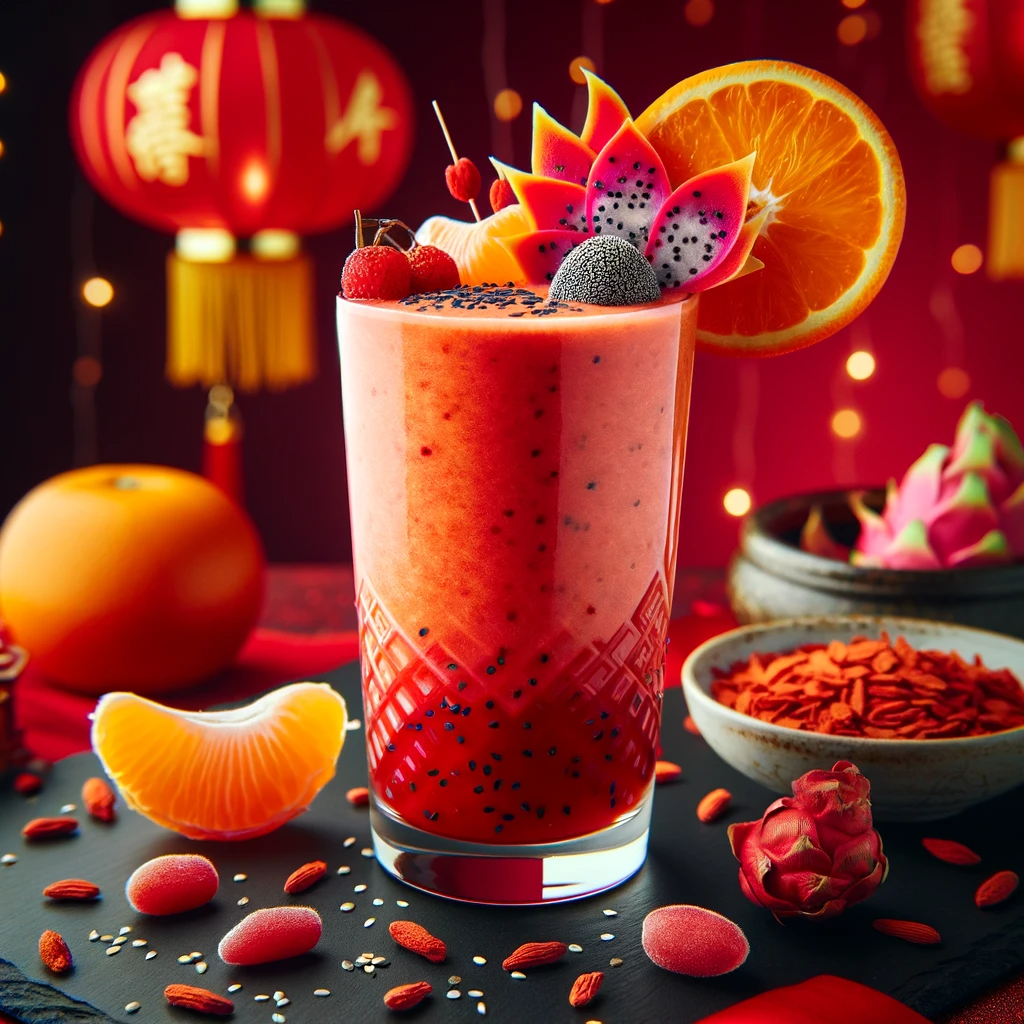Ugadi/Gudi Padwa Special Smoothie Recipe
The image vividly captures the festive atmosphere of the Ugadi/Gudi Padwa celebration. It showcases a bustling street scene adorned with mango leaves and marigold flowers, with people of all ages dressed in colorful traditional attire engaging in various festive activities. The joy and cultural richness of the festival are highlighted by the presence of street vendors, ritualistic prayers, and the enjoyment of traditional foods like Ugadi Pachadi. This portrayal brings to life the community spirit and cultural heritage that are hallmarks of this significant festival.
The image beautifully captures the Ugadi/Gudi Padwa Special Smoothie, presented in a clear glass against a festive backdrop. The smoothie is made from neem leaves, green mango, jaggery, banana, and a hint of tamarind, elegantly topped with cardamom and neem leaves. Surrounding the glass are the ingredients used in the smoothie, including slices of green mango and a small bowl of jaggery, all artfully arranged to reflect the vibrant spirit of the Ugadi and Gudi Padwa celebrations. The setting includes traditional elements like mango leaves and marigold flowers, enhancing the cultural connection and inviting viewers to enjoy a healthful and thematic beverage during the festival.
Baisakhi Harvest Smoothie Recipe
The image vividly captures the essence of the Baisakhi festival, showcasing a vibrant and joyous celebration in the fields of Punjab. Farmers and families, adorned in traditional attire, are seen participating in the festivities, with the Bhangra and Giddha dances bringing the scene to life. The lush green fields ready for harvest, flying kites in the sky, and stalls selling traditional Punjabi food and crafts further enhance the festive atmosphere. The presence of children playing with toy tractors adds a playful element, emphasizing the agricultural significance of Baisakhi. This scene beautifully conveys the community spirit, cultural richness, and celebratory mood of Baisakhi as a time of thanksgiving and hope for prosperity.
The image beautifully presents the Baisakhi Harvest Smoothie, set against a rustic wooden table backdrop. The smoothie, a rich blend of the vibrant colors from carrots, spinach, and mangoes, is elegantly topped with crushed almonds. Accompanying the glass are the fresh ingredients used in the smoothie: chopped carrots, spinach, mango slices, Greek yogurt, soaked almonds, and honey, with a sprinkle of cardamom powder for added flavor. Elements of Punjabi culture, such as miniature tractors and colorful Bhangra figurines, adorn the setting, celebrating Baisakhi’s agricultural roots and vibrant festivities. This setup invites viewers to partake in a healthy and culturally rich festive treat.
Puthandu Prosperity Smoothie Recipe
The image vividly portrays the Puthandu (Tamil New Year) festival, capturing a bustling street scene filled with traditional decorations such as kolams (rice flour designs), mango leaves, and marigold flowers. People of all ages, dressed in vibrant silk sarees and dhotis, are seen engaging in various activities—some making kolams, others visiting temples, and children playing with fireworks. Vendors selling festive items and traditional Tamil sweets add to the lively atmosphere, which is enriched by the sounds of classical music and the scents of fresh flowers and incense. This scene beautifully reflects the cultural richness, community spirit, and celebratory mood of Puthandu, showcasing the essence of Tamil culture and traditions.
The image beautifully presents the Puthandu Prosperity Smoothie, served in a traditional South Indian brass or copper vessel, which enhances the cultural significance of the recipe. The smoothie’s vibrant yellow color, enriched with hints of orange from the mango and a golden glow from saffron, vividly stands out. Accompanying the vessel are neatly arranged ingredients: ripe mango slices, banana, coconut milk, cashews, saffron, cardamom, turmeric powder, and jaggery. The setting is further adorned with a garland of marigold flowers and mango leaves, symbolizing prosperity and auspiciousness in Tamil culture, set against a rustic, earthy background. This setup not only invites viewers to celebrate Puthandu but also portrays the nutritious and symbolic essence of the smoothie.
Poila Boishakh Bliss Smoothie Recipe
The image vividly portrays the Poila Boishakh festival, capturing the vibrant and colorful atmosphere of a street celebration. It features traditional decorations such as alpana and marigold flowers, with people of various ages dressed in traditional Bengali attire. Men playing the dhak and women performing folk dances enhance the cultural display, while children enjoy sweets and toys, contributing to the festive spirit. Vendors selling classic Bengali sweets like sandesh and rasgulla line the streets, completing the lively scene that embodies the joyful spirit and rich cultural heritage of the Bengali New Year.
The images beautifully present the Poila Boishakh Bliss Smoothie, served in traditional Bengali terracotta cups. Each smoothie showcases a rich golden color from mangoes, enhanced by the creamy texture of coconut milk, and is elegantly topped with cardamom and puffed rice grains. Accompanying elements include ripe mango slices, banana, coconut milk, date palm jaggery, and a jar of puffed rice, set against a vibrant yet rustic background featuring Bengali cultural motifs. These settings perfectly capture the festive spirit of Poila Boishakh, inviting viewers to enjoy this nutritious and symbolic beverage.
Navreh Nectar Smoothie Recipe
The image vividly portrays a vibrant and festive scene from Navreh, the Kashmiri New Year, set in a traditional Kashmiri home. It captures a family engaged in New Year rituals, including the arrangement of the Thaal—a ceremonial plate filled with symbolic items. Dressed in traditional Kashmiri attire, the family members perform rituals and prayers, surrounded by marigold flowers and saffron strands, against a backdrop of intricate wooden carvings typical of Kashmiri architecture. This setting beautifully reflects the cultural richness and celebratory mood of Navreh.
The images beautifully present the Navreh Nectar Smoothie, served in traditional Kashmiri khos (cups), reflecting the cultural significance of Navreh, the Kashmiri New Year. Each smoothie showcases a rich blend of golden hues from saffron, creamy whites from yogurt, and the natural colors of apples and walnuts. The ingredients are elegantly arranged beside the khos, including vibrant saffron strands, freshly chopped apples, a bowl of walnuts, a jar of honey, and a container of Greek yogurt, all set against a backdrop of traditional Kashmiri motifs. These settings perfectly capture the essence of renewal and festivity associated with Navreh, inviting viewers to indulge in this nutritious and symbolic beverage.

